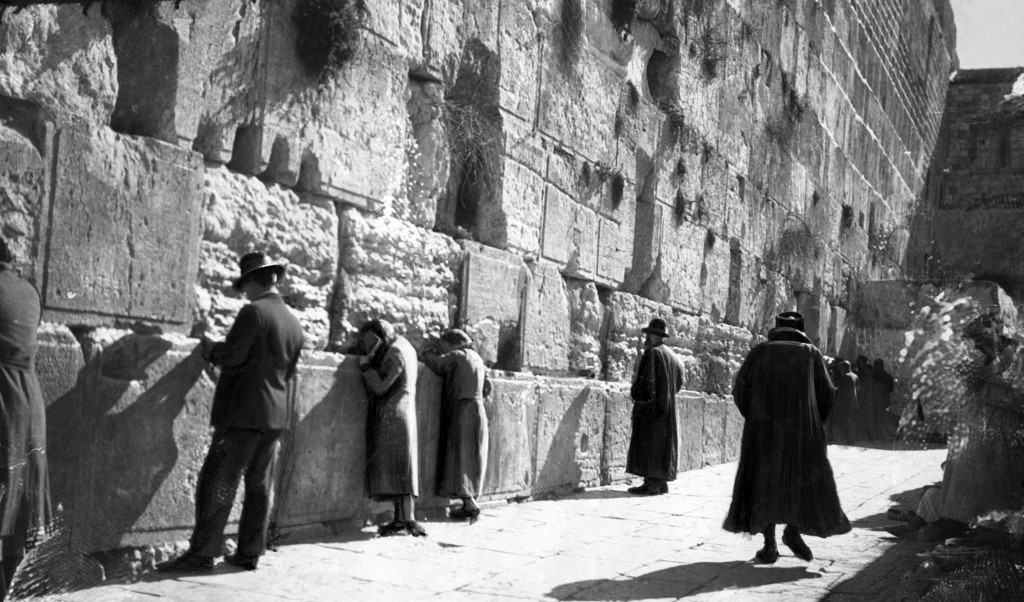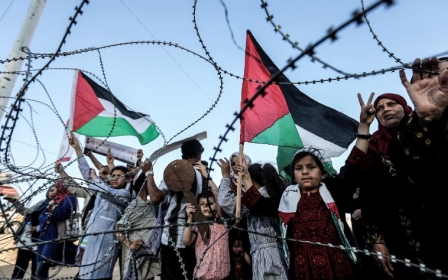Nakba: The forgotten 19th century origins of the Palestinian catastrophe

The Nakba, Palestinians’ loss of their lands and homes, arguably began in the 1880s with the arrival of the first Zionist Jewish colonists, who evicted Palestinians from land the colonists had purchased from absentee landlords.
The Nakba is an ongoing calamity that continues to define the Palestinian condition today. 1948 and 1967 are watershed dates of larger and more monumental losses of land and rights, and 1993, the Oslo year, is a watershed date of Palestinians’ loss of their right to retrieve their stolen homeland through the collaboration of what once was their liberation movement.
But Zionist Jewish colonisation of Palestine was a culmination of European Christian efforts to colonise Palestine since Napoleon’s invasion and defeat in Acre in 1799 at the hands of the Ottomans and their British allies.
Indeed, this European Christian colonisation of the country throughout much of the 19th century was the prelude to Zionist Jewish colonisation at the end of it.
Fanatical missionaries
While the Protestant Reformation was the first Christian European movement to call for Jews to be converted and “return” to Palestine, it was the British who began the plans for colonisation and Christianisation pioneered by the fanatical missionaries of the London Society for Promoting Christianity Amongst the Jews (founded in 1809), known popularly as the London Jews Society.
Anglican zealots sought to convert European Jews and encourage their emigration to Palestine, where they established a missionary network. In the 1820s, this society, sponsored by British politicians and lords, was led by Jewish converts who saw fit to send more Jewish converts to Palestine to proselytise the Jews.
Things changed measurably in the last two decades of the 19th century, as early Zionist Jewish immigration began from the Russian colonial settlement of Odessa
Soon, the British established the first foreign consulate in Jerusalem in 1838, and the Church of England established an Anglican Bishopric in the holy city in 1842.
The first bishop, Michael Solomon Alexander, was a German Jewish convert who had been a rabbi before his conversion. The British bought land and their consul set up several institutions to employ Jews in agriculture, among other things. The British colonists themselves also began to buy land and to dabble in agriculture.
By the 1850s, Palestine’s population was under 400,000 people, including about 8,000 Jews. Half were Palestinian Jews who had escaped the Spanish Inquisition in the 16th century; the other half were Messianic kabbalistic Jews, who came in the early decades of the 19th century from Russia in anticipation of the arrival of the Messiah.
The London Jews Society converted a few dozen, but rabbis fought back and excommunicated Jews who dealt with the missionaries. They appealed to European Jewish benefactors, the Rothschilds and Moses Montefiore, for help. The latter set up hospitals and bought land for poor Jews, lest they convert to Protestantism.
'Scramble for Palestine'
The first major European war to inaugurate what we should call the colonial “scramble for Palestine” - namely, the Crimean War of 1853-1856 - was caused by European claims to “protect” Palestine’s Christians. The war was instigated by French and British concerns that Russia was planning to take over Palestine, especially with the large annual Russian Christian pilgrimage to Jerusalem for Easter.
Aside from the jealousy and concerns of Western European Christian powers about Russia’s real and imagined expansionism at the expense of a weakened Ottoman Empire, over which France and Britain had acquired huge influence, the sense that Palestine - including its holy Christian sites and Arab Christian population - should be a concern solely for Western Christian powers would come to threaten Russian interests.
The Russians were nervous about the advances in Protestant and Catholic institutions in Palestine, let alone the neglect and corruption of the Greek clergy in charge of Orthodox Palestinians since the 16th century, placed in power by the Ottomans following the death of the last Palestinian Patriarch Atallah in 1543.
In the run-up to the Crimean War, European Latin Catholics insisted on the restoration of their exclusive rights to Palestinian Christian holy places that were established under the Crusades, regained under the Mamluks in the 14th century, but lost to the Greek Orthodox church upon the Ottoman conquest.
The Ottomans issued an edict that restored some of their privileges at the expense of the Orthodox in the Holy Sepulchre, the Church of the Nativity and Gethsemane. The Palestinian Orthodox - clergy and laity - were up in arms, as was Tsar Nicholas I. This became the casus belli for the Crimean War. With Russia’s defeat, the Latin Catholic and Protestant missionary invasion of Palestine accelerated manifold.
British zealots
In the meantime, another fanatical missionary organisation, the Church Missionary Society, founded in 1799, arrived on the scene in 1851 to convert Palestinian Eastern Christians. The British zealots established schools, dispensaries and medical facilities to help gain converts, while being resisted by Eastern Christian churches across Palestine.
In response to the missionaries, a French Jewish statesman established the Alliance Israelite Universelle schools in 1860 for Ottoman Jews. Agricultural endeavours aimed at the Jewish population were also established by a French Jewish philanthropist.
On the US front, American Protestant missionaries were dispatched in the 1820s to Palestine but decided to try their luck in Syria and left in the 1840s, assured that their British co-religionists would take care of the Palestinians.
But others followed, including dozens of Adams colonists, former Mormons who set up a settler-colony in Jaffa between 1866 and 1868 to prepare the land for the “return” of the Jews who would be converted before the Second Coming. Their efforts failed, but this was for the benefit of a new community of German Protestant colonists, known as the Templers, who arrived in Palestine in the 1860s and established a number of colonies countrywide, including on the Adams colony lands in Jaffa.
The German navy came to the shores of Palestine to defend them during the Russian-Ottoman War of 1877-78. The Templers wanted to turn Palestine into a Christian state and hoped it would be awarded to Germany after the war, but they were to be disappointed. They prospered until the British and, after them, the Jewish Zionists harassed them out of the country.
More Americans also came in 1881, like the Chicago fundamentalist family, the Spaffords, who established a colony in Jerusalem. They were joined by Swedish fundamentalists in the 1890s. They bought the palace of Rabah al-Husayni to set up their colony. Today it is the American Colony Hotel in Jerusalem.
Prelude to more calamities
European kings and queens visited the country and interceded on behalf of their missionaries, demanding more rights and privileges for them. But things changed measurably in the last two decades of the 19th century, as early Zionist Jewish immigration began from the Russian colonial settlement of Odessa, itself built on the ruins of the Ottoman town of Hacibey.
The London Jews Society was ecstatic that there were more Jews arriving whom it could convert. It set up in London the Jewish Refugees’ Aid Society to facilitate their immigration. Moses Friedlaender, a Jewish convert, was put in charge in Palestine. Land was purchased for the Jewish colonists southwest of Jerusalem, but as the Rothschilds were already founding Jewish colonies, most of Friedlaender’s Jewish adherents joined the Zionist colonies in 1886.
Their colonial sponsors realised that the best possible scenario for European colonial settlement in Palestine was a Jewish settler-colony allied with Protestant fundamentalism
Despite this failure, the London Jews Society claimed to be forerunners of Jewish colonisation in the country, suggesting that Jewish philanthropists were provoked to “jealousy and emulation”. This is when the Jewish Lovers of Zion (Hovevei Zion) colonists from Odessa arrived and established the first Zionist colonies, beginning the Palestinian Nakba that has lasted up until today.
The zealotry of the British, German and US Protestant colonists in Palestine in the 19th century was the prelude to so many more calamities to hit the Palestinian people. Jewish fanatical Zionists would finish the job.
Today’s American Evangelical fanatics who support the ongoing Zionist colonisation of the land are as antisemitic as their 19th-century predecessors. Yet, at the end of the 19th century, Protestant fanatics realised that Palestine could not be converted into a Protestant country as they were able to convert only about 700 Jews and 1000 Palestinian Eastern Christians by then.
Their colonial sponsors realised that the best possible scenario for European colonial settlement in Palestine was a Jewish settler-colony allied with Protestant fundamentalism. This is what Zionism was in the 19th century, and remains today.
The views expressed in this article belong to the author and do not necessarily reflect the editorial policy of Middle East Eye.
Middle East Eye propose une couverture et une analyse indépendantes et incomparables du Moyen-Orient, de l’Afrique du Nord et d’autres régions du monde. Pour en savoir plus sur la reprise de ce contenu et les frais qui s’appliquent, veuillez remplir ce formulaire [en anglais]. Pour en savoir plus sur MEE, cliquez ici [en anglais].







